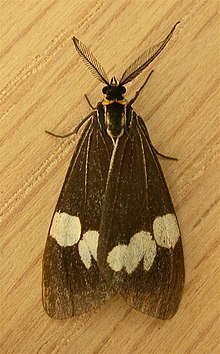| Nyctemera amicus | |
|---|---|

| |
| Scientific classification | |
| Domain: | Eukaryota |
| Kingdom: | Animalia |
| Phylum: | Arthropoda |
| Class: | Insecta |
| Order: | Lepidoptera |
| Superfamily: | Noctuoidea |
| Family: | Erebidae |
| Subfamily: | Arctiinae |
| Genus: | Nyctemera |
| Species: | N. amicus |
| Binomial name | |
| Nyctemera amicus (White, 1841) | |
| Synonyms | |
| |
Nyctemera amicus, the senecio moth, magpie moth or cineraria moth, is a moth of the family Erebidae. The species was first described by Adam White in 1841. It is found in South-east Asia, Oceania, and most of Australia. It can also be found in New Zealand.

The larvae feed on Senecio species including S. linearifolius, S. quadridentatus, S. mikanioides, S. cruentus, and S. scandens. These food plants contain pyrrolizidine alkaloids, making the larvae unpleasant to taste and poisonous to birds.
References
- "Nyctemera amicus (White, 1841)". Atlas of Living Australia. CSIRO. Retrieved 16 July 2017.
- Research, Landcare. "Nyctemera amica (White, 1841)". New Zealand Organisms Register. Landcare Research New Zealand Ltd. Retrieved 2017-07-16.
- Herbison-Evans, Don & Crossley, Stella (11 June 2018). "Nyctemera amicus (White, 1841) Senecio or Magpie or Cineraria Moth". Australian Caterpillars and their Butterflies and Moths. Retrieved 3 September 2019.
| Taxon identifiers | |
|---|---|
| Nyctemera amicus | |
This Nyctemerina-related article is a stub. You can help Misplaced Pages by expanding it. |